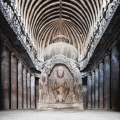ELLORA CAVES
Group of cave temples in Ellora, marking the 3 religions that dominate the country: Buddhism, Hinduism and Jainism
The magnificent group of cave temples at Ellora, a UNESCO World Heritage Site, represents the three dominant religions of India and marks the final phase of rock building in Western India. The harmonious coexistence of Buddhism, Hinduism and Jainism beautifully illustrates the fervent universality of the kings and peoples of the time. The construction of works of this importance can indeed only see the light of day in periods of peace and prosperity. The site would count a total of a hundred caves scattered on the Charanandri hill. The 34 caves open to the public are dug in a cliff of more than 2 km length. The best time to visit the site is early in the morning, before the arrival of tourist buses and the heat.
The Kailash temple (n° 16): at the end of the alley that starts in front of the entrance ticket office. This Hindu temple carved around 760 under the aegis of King Krishna I of the Rashtrakuta dynasty is the largest monolithic structure in the world. Excavated from the basalt cliff, it represents Mount Kailash, the abode of Shiva. The temple is 45 meters long and 30 meters wide and it is estimated that no less than 400,000 tons of rock had to be removed to bring it into being. The work would have lasted nearly one century. The temple is surrounded on three of its faces by a gallery dug in the rock. Stone footbridges allowed to pass from the temple to the galleries, but they collapsed. The plan follows what will become the classical Dravidian architecture: an entrance(gopuram) leading to a nandi mandapa (pavilion dedicated to Shiva's mount, the bull, Nandi) and a sanctuary housing a linga (phallic incarnation of Shiva). Outside, a frieze of elephants seems to carry the whole weight of the temple. The originality of this temple, in addition to being monolithic, is its structure on two levels, the nandi mandapa being connected to the sanctuary by a footbridge. You will notice the extraordinary work of sculpture. In some places, one can also observe traces of painting which explains its local nickname: palace of color(ranga mahal). At the foot of the temple, on its right, a small path climbs to the top of the cliff, from where you can enjoy the view and visualize the titanic work accomplished. Beware of the langurs which squat the site in number.
The Buddhist caves (n° 1 to 12) : all these caves are viharas (monks' living places) except for the cave n° 10 which is a chaitya (temple). The cave n° 2 contains an impressive representation of Buddha, as well as beautiful carved columns. The huge cave n° 5 must have been used as a refectory or a place of assembly, as the stone benches on the ground testify. The cave n° 6 offers beautiful representations of Tara. In cave 8, the sanctuary is detached from the back wall for the first time. Cave 10 is exceptional for its ceiling, its large statue of Buddha and its bas-reliefs. Dug around the 8th century, it is one of the most beautiful chaitya
of India. The caves n° 11 and n° 12 are much more impressive by their size. Dug in the 8th century, it is possible that the sculptors wanted to compete with the Hindu temples of the same period. In the cave n° 12, the immense Buddha operates the Wheel of the Law.Hindu caves (n° 13 to 29) : much larger, more ornamented and of a much better execution than the Buddhist caves, the Hindu caves testify of a proselyte ambition. Ravana-ki-Khai (n° 14) was a vihara converted into a Hindu temple during the 7th century. Beautiful bas-reliefs on the side walls. Dashavatara (n° 15) is one of the most beautiful temples of Ellora. Built on two floors, the first floor is poorly decorated. The staircase leads to a courtyard in the center of which stands a central pavilion which was supposed to house Nandi (Shiva's mount). It is decorated on the outside with reliefs and pilasters, as well as with garas, the pot-bellied dwarfs who serve Shiva (on the cornice). Inside, reliefs represent Shiva, Vishnu or his avatars. Rameshvara (no. 21) illustrates the importance of the sacred rivers Ganges and Yamuna by allegories: Ganga riding a sea monster, in particular. The caves n° 17 to 20 and n° 22 to 28 are not of major interest. They were probably simple monasteries. The cave n° 29, Dhumar Lena, is one of the first Hindu caves. There is a beautiful waterfall during and after the monsoon. It is closed to the public until further notice because the paths leading to it are dangerously eroded.
The Jain caves (n° 30 to 35) : the Jain caves date from the 9th and 10th centuries. Smaller in size than the other caves on the site, they bear witness to the asceticism of the Jain movement. Nevertheless, they present numerous sculpted details of a rare finesse of execution. The cave n° 30 or Chhota Kailash and the cave n° 33 called Jagannath Sabha will hold your interest for their sanctuary. The most interesting is undoubtedly the cave No. 32, Indra Sabha, carved in the rock on two levels. Do not miss the lotus flower which decorates the ceiling of the first floor and the representation of Ambika on thefirst
floor, riding a lion under a mango tree covered with fruits. The access to the cave n° 34 is done by the Janagannath Sabha cave. A free bus makes the shuttle between the entrance of the site and the Jain caves.Did you know? This review was written by our professional authors.
Book the Best Activities with Get Your Guide
Members' reviews on ELLORA CAVES
The ratings and reviews below reflect the subjective opinions of members and not the opinion of The Little Witty.

